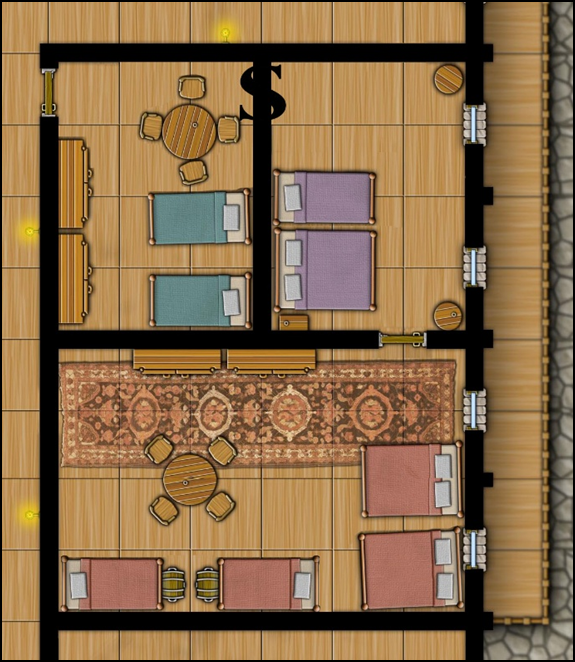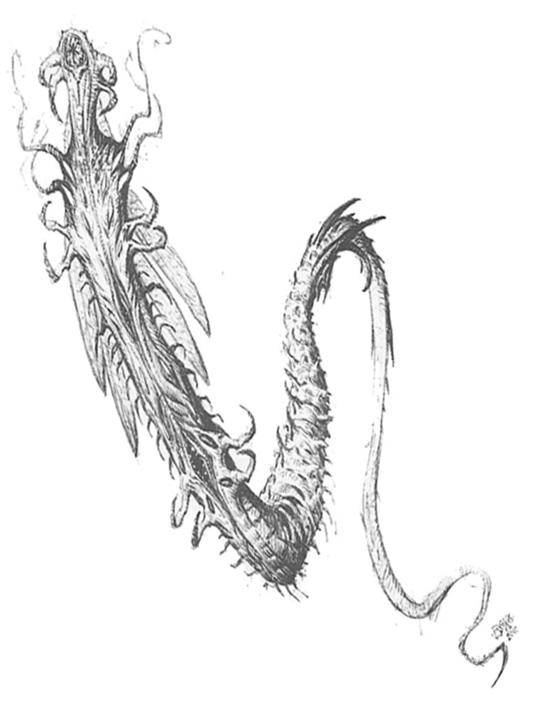The slave trade in Ptolus is a gray market: It’s illegal to sell a slave within the city limits, but not illegal to own one (although more and more people disapprove or outright loathe the practice). The local trade is dominated by the Ennin, whose operations extend far beyond Ptolus and openly use the city as a distribution center while also maintaining a surreptitious black market.
The Vladaams don’t directly trade slaves, per se, but have deeply entwined themselves with the Ennin’s operations. There are some who consider the Ennin little than a front for the Vladaam, but this is not accurate. The Ennin are actually, unbeknownst to the Vladaams, a front for the Pactlords of the Quaan (Ptolus, p. 125). Most of the Ennin’s leadership are, in fact, Pactslaves.
For their part, the Vladaams are involved with the slave trade in two ways:
- The Vladaams maintain a warehouse as a place where the Ennin can temporarily store slaves who are going to be sold at the Ennin Slave Market (Ptolus, p. 399)
- The Fleet of Iron Sails – specifically the Pride of Morrain, Eye of the East, and Sarathyn’s Sail – are regularly used to transport slaves for the Ennin. These ships collect slaves from the Serpent’s Teeth and deliver them to the Ennin Headquarters (Ptolus, p. 168).
The Vladaam operations are detailed below, while details of the Ennin facilities can be found in the Ptolus sourcebook, as indicated above.
VLADAAM SLAVE SHIPS
The Pride of Morrain, Eye of the East, and Myliesha’s Sail each have a 50% chance of carrying a cargo of slaves. Otherwise, they’re currently carrying normal goods. Check The Fleet of Iron Sails to determine how often they can be found at port in Ptolus.
SMELL OF THE SLAVE SHIPS: The Vladaam Mages assigned to these ships regularly cast prestidigitation to clean out the holds, but it’s not enough to purge the sickening stench that clings to the slave holds – a mix of filth, excrement, blood, and putrescence.
CREWS
Captain: As detailed for each vessel.
Vladaam Mage: Use mage stats, MM p. 347. See Part 13: Red Company of Magi.
Vladaam Guards (1d6-2): Banewarrens, p. 45.
Advanced Vladaam Guards (1d6-2): Use knight stats, MM p. 347.
Sailors (2d8 x 3): Use commoner stats, MM p. 345.
- Proficiency: Athletics, Perception, Navigator’s tools, vehicles (water).
- Equipment: dagger, corncob pipe, chewing tobacco, 2d10 sp, Vladaam deot ring
SLAVE RUNS
- Half Load: 2d4 x 10 slaves
- Full Load: 4d8 x 10 slaves
VLADAAM SLAVE WAREHOUSE
This facility can temporarily store slaves who are going to be sold at the Ennin Slave Market. It’s used as either an overflow storage facility or as a place where the current stock of the Slave Market can be evacuated if the market is threatened by law enforcement. The Vladaams offer this service gratis in exchange for being allowed to use the slaves to process Liquid Pain (in area 9).
DARK LEAF: In order to distance the facility from the Vladaams, the security is managed by Dark Leaf mercenaries (Ptolus, p. 108) overseen by a centaur named Dilar.
DILAR: Dilar is a captain in Dark Leaf and in charge of the mercenaries here, but he is also deeply in debt as a result of gambling at the Oldtown curse den. Unbeknownst to either the Vladaams or Dark Leaf, Dilar is also involved with the chaos cults. (He appears in Night of Dissolution, p. 37, overseeing a meeting at a secret meeting hall just across the street from this warehouse.)
MALAR: Malar is lieutenant in Dark Leaf. He and the centaur used to be friends, but tensions and suspicions surrounding Dilar’s debts and cult activity have driven them apart. Malar would like to either supplant Dilar in Dark Leaf or make the hop to a better position with either the Vladaams or Ennin.
DENIZENS OF THE WAREHOUSE
DENIZENS LOCATION
2 Dark Leaf Mercenaries Entrance
2 Dark Leaf Mercenaries Area 1
2d6 unskilled laborers Areas 1 & 2 (day only)
6 Dark Leaf Mercenaries Area 7
2 Vladaam Mages + 50% chance of 1d4 slaves Area 9
DILAR (d100)
- 01-25: Area 1
- 26-75: Area 7
- 76-00: Not present
MALAR (d100)
- 01-50: Area 7
- 51-75: Area 9
- 76-00: Not present
Dilar: Use veteran stats (MM, p. 350) with centaur traits.
- +1 greatsword: Melee Weapon Attack: +6 to hit, reach 5 ft., one target. Hit: 11 (2d6+4) slashing damage.
- Alignment: Chaotic Evil
- Equipment: splint armor, +1 greatsword, ring of jumping, broken square ring, coiled viper amulet worth 10 gp, Vladaam house ring, 1 gp, 14 sp
- Languages: Common, Elven
Centaur traits:
- Charge: If Dilar moves at least 30 ft. straight toward a target and then hits them with a melee attack on the same turn, they target gains an extra 10 (3d6) piercing damage.
- Multiattack: Dilar makes two attacks, one with his sword and one with his hooves.
- Hooves: Melee Weapon Attack: +6 to hit, reach 5 ft., one target. Hit: 11 (2d6+4) bludgeoning damage.
Dark Leaf Mercenary: Use veteran stats (MM, p. 350) with wood elf traits.
- Speed 35 ft.
- darkvision 60 ft.
- Spells: druidcraft, detect magic (1/day)
- Fey Ancestry: Advantage on saving throws vs. Charmed condition.
- Trance: Immune to sleep. Finish Long Rest in 4 hours.
- Equipment: Vladaam house ring
- Languages: Common, Elven
Malar: Use master thief stats (Ptolus, p. 612).
- Malar has a Balacazar fiendish slave amulet (Ptolus, p. 398) which allows him to summon a Shoggti (Book of Fiends 5E, p. 199). The shoggti emerges by having its tentacles erupt through the surface of the amulet. There is an ornate B stamped on the back of the amulet, certifying it as a creation of the Balacazars.
- Equipment: Vladaam house ring
Unskilled Laborer: Use commoner stats (MM, p. 353).
Vladaam Mage: Use mage stats, MM p. 347. See Part 13: Red Company of Magi.
Ptolus Map – H6
AREA 1 – WAREHOUSE
This front area operates as a legitimate warehousing business, run by the Vladaams and servicing various local businesses and markets. The ceiling is 50 feet high.
AREA 2 – UPPER WAREHOUSE
This area is basically a very large “ledge” about ten feet above the level of Area 1.
GM Background: This elevated area exists only to make room for the lower storerooms (Areas 4-6). Architecturally this doesn’t make much sense, though. The unintuitive layout exists only to obfuscate the existence of the slave warehouse below.
AREA 3 – STAIRS
These stairs lead down to Area 4.
ALARM: The head of an antlered buck has been hung on the wall of the landing. It has an alarm spell that sends a mental alarm to Dilar. The alarm is triggered by anyone who doesn’t wear a Vladaam house ring.
GM Note: The laborers never use these stairs.
AREA 4 – LOWER HALLWAY
This stone hallway is rarely used.
AREA 5 – LOWER STOREROOMS
These storerooms have the appearance of being used for legitimate storage (barrels, casks, boxes, crates, etc.). Any inspection, however, reveals that there’s a thick coating of dust on everything. Opening the crates reveals that they contain mostly garbage and miscellaneous junk.
GM Background: These storerooms exist only to provide a pleasant fiction masking the entrance to the slave warehouse in Area 6.
AREA 6 – ENTRANCE TO THE SLAVE WAREHOUSE
At first glance, this area is identical to Area 5.
DC 20 Intelligence (Investigation): Several crates along the back wall are fastened together. They can be unlatched from the wall and then slid away to reveal the stairs leading down to Area 7.
AREA 7 – SLAVE WAREHOUSE
A floor of bare stone, worn smooth with a single trap door in it to the right of the stairs. A board with various papers and bills of sale pinned to it has been placed on the wall next to the stairs. A bank of ten levers on the wall to the left. Multiple cell doors line the far wall, extending down a hallway to the right.
LEVERS: A bank of ten levers. They require a key (which is held by someone in this room; with a duplicate held by Dilar) and open the nine cell doors and the secret door.
TRAP DOOR: A spiral stair below the trap door leads down to Area 9.
SECRET DOOR – DC 20 Intelligence (Investigation): The secret door to the east leads to a section of old sewer that was capped and bypassed during a sewer renovation long ago. A section of this sewer breaks through into a portion of Ghul’s Labyrinth, which provides access to the Ennin Slave Market.
POSTED BILLS: Includes the Business of the Vladaam Slave Warehouse handout.
IRON COFFER (10%): There’s a 10% chance an iron coffer is present containing 500 gp, 40,000 sp, and 50,000 cp with instructions to have the Ithildin couriers ship it to the Red Company of Goldsmiths on Gold Street.
AREA 8 – SLAVE CELLS
The facility typically holds 2d20 slaves as an overflow facility from the Ennin Slave Market.
- 75% chance per ship that some of the slaves here were shipped in on the Pride of Morrain, the Eye of the East, or the Myliesha’s Sail. (See Vladaam Slave Ships, below.)
BIG CELL: 25% chance that the large cell holds a special creature/slave. If this is the case, double the number of mercenaries in this room. Examples of such “special guests” could include:
- 1d4 cockatrices
- 1d4+1 ogres
- 1d2 hippogriffs
- Giant Ant Queen
AREA 9 – LIQUID PAIN FACILITY
The main area of this chamber is outfitted as a high-end alchemy laboratory.
COTS: Two eastern niches contain cots on which Vladaam Mages sleep. Small trunks slid under each cot contain (see handouts):
- Vladaam Slaver Mage Spellbooks
- Instructions for the Apparatus of Liquid Pain
LIQUID PAIN APPARATUS: The western niche contains four upright glass cylinders, each large enough to hold an erect man or woman. Shackles suspended from the ceiling allow the Vladaams to string up slaves upside down within each cylinder, while various tubes, syringes, and metallic attachments can be fastened onto someone so hung.
- Liquid Pain: The apparatus allows one to withdraw 2d8 doses of agony (“liquid pain”) from a person suspended within one of the glass cylinders. The procedure lasts for ten minutes and the victim must make a DC 18 Wisdom saving throw or suffer 2d6 Constitution damage. (This is treated as psychic damage for the purposes of immunity and resistance.) On a successful save both the damage and the yield are halved.




















